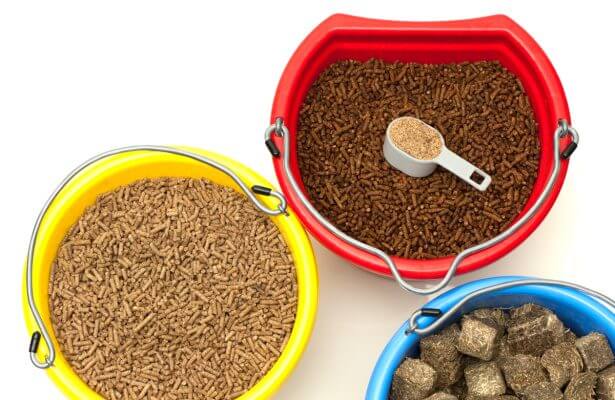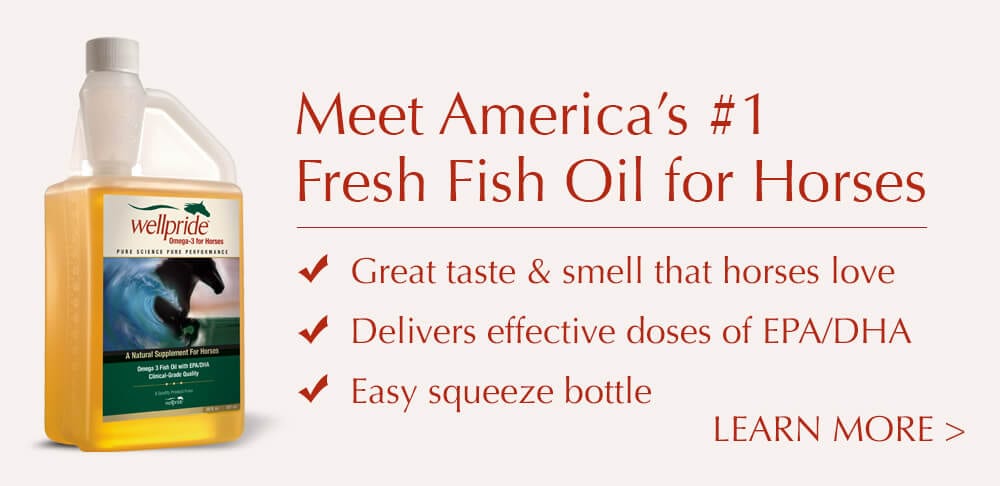Do Equine Omega Supplements Contain Mercury?
Wellpride hears a lot of questions within the horse industry about fish oil purity. Horse owners want to know exactly what they are giving their horses, and with good reason. It’s important to know what ingredients are in the omega products you feed, how fresh they are, and whether they have been tested for some form of quality assurance.
For those seeking more information on this, we offer up a Q&A session with Wellpride’s Dr. Anne-Marie Chalmers, who founded the company with her husband, Dr. Bo Martinsen. Dr. Chalmer’s research and development work has included nutraceuticals, most notably omega-3s, and medical delivery device systems to facilitate ingestion of multiple medication combinations. She also practiced family medicine in Norway for many years.
How Fish Oil Is Made
Q: What is fish oil made of?
Anne-Marie Chalmers, MD: Most fish oils are made as a byproduct from fish meal manufacturing. Fishmeal is simply the name for the ground up, dried fish that’s often used as feed for farmed fish and animals.
Fish oil can be made using a variety of fish species, but it is usually derived from small, oily fish, such as sardines, anchovies, herring, and small mackerel. It is also possible to use the internal organs and trimmings from salmon and tuna processing to make fish oil.
Q: Why do you use human-grade fish oil for your equine omega 3 product, Wellpride?
AMC: The reason we use a human-grade fish oil for our equine omega 3 supplement is that the refineries producing human-grade oil are technologically more advanced than refineries making non-human-grade oils. Refineries producing human-grade oils are able to make a superior fish oil with lower oxidation levels (i.e., better freshness levels). Of course, freshness and purity are crucial for both you and your horse.
You can buy cheap fish oil for very little. But the quality and the way it has been handled from the moment the fish come out of the ocean to the time the final product reaches the consumer is going to determine both the taste of the oil and how effectively it works.
Q: How is fish oil typically produced?
AMC: As explained above, fish oil typically comes from a blend of small, oily fish. When these fish are ground up or “milled,” they release oil.
About 75% of the fish is made up of water, so only about 5-10% of the fish weight becomes oil. The oil is separated from any water and proteins, filtered, and then cleaned to remove impurities. Finally, antioxidants are added, and the oil is placed in stainless steel containers and flushed with nitrogen, which helps keep oxygen from gaining access to the fish oil. This is important, since exposure to oxygen is what causes fish oil to turn rancid.
Depending on the oil and the manufacturer, a fish oil can go through a variety of purification processes. The majority of fish oils are purified in Norway.
How Fish Oils Are Purified
Q: What purity standards help ensure fish oil products are safe?
AMC: In Europe, the European Food Safety Authority (EFSA) provides independent scientific advice on all subjects impacting food and feed safety, including animal health and welfare. But outside the European Union, the standards can vary from country to country.
In the United States, the Food and Drug Administration (FDA) has certain requirements that have to be fulfilled by fish oil companies. And California’s Proposition 65 on drinking water regulation is stricter than the laws of other states. It presents requirements for the amount of toxins allowed, not only in drinking water, but also in fish oil.
In addition, the following organizations set purity and freshness guidelines for fish oil companies to follow: Eurofins Scientific, Council for Responsible Nutrition (CRN), the International Fish Oil Standards Program (IFSP), the Global Organization for EPA and DHA Omega-3s (GOED), and the United States Pharmacopeia (USP).
In most cases, companies self-regulate to make sure they abide by the limits with regards to toxins. However, sometimes tests are also made by incognito government officials who buy a finished product and then analyze it to make sure that what is stated on the label is actually in the bottle.
Q: What is a Certificate of Analysis, and why does it matter?
AMC: The Certification of Analysis is an analysis that measures the ingredients of a product and confirms the manufacturer’s claims. The Certificate of Analysis can give you some important insight into the quality of the oil. For instance, it can tell you the ratio of EPA/DHA in the oil, its freshness levels at the time of analysis, and of course, the purity values.
Q: How do you read the Certificate of Analysis?
AMC: The peroxide, anisidine, and TOTOX values are oxidation measurements, and they demonstrate how “fresh” the oil is. You can learn more about what they mean in this article:” Making Sense of Fish Oil Oxidation Values.” As a rule of thumb, the lower the oxidation values are, the better. The industry has set values for what’s considered the acceptable upper range oxidation values: a peroxide value of 5 mEq/kg, an anisidine value of 20, and a TOTOX value of 26.
When looking at the oxidation values, however, it’s important to keep in mind that the Certificate of Analysis is like a report card from last semester. Certain values, like the peroxide, anisidine and TOTOX values, might have changed since they were measured. And unfortunately,studies show that most fish oils surveyed for the human market have oxidation values exceeding the industry standards at the time of purchase. That’s why it is important to taste and smell the oil after you purchase it to make sure it is still good.
In terms of heavy metals, according to the GOED Voluntary Monograph, the values for mercury, lead, arsenic, and cadmium should all be less than 0.1 ppm (mg/kg). And for polychlorinated biphenyls (PCBs), the values should be less than 0.09 mg/kg. Now, most of the time, on a Certificate of Analysis, the values for these categories will simply be written as “conforms” or “pass.” This means that in the batch test, these values were all found to have passed those requirements.
Positively, studies of fish oil supplements find that products contain “negligible” amounts of mercury or other harmful pollutants. In other words, it’s important to check that the oil has been purified, but it’s usually not what you have to be most concerned about.
Q: Besides heavy metals, are there other contaminants that one has to be concerned about?
AMC: Fish oil has strong anti-microbial properties, so concerns over bacteria, yeast, and mold are typically not warranted. In fact, due to the emergence of resistance to many antibiotics, researchers have started to explore how the omega-3 fatty acids EPA and DHA inhibit pathogenic microorganisms. This is especially exciting since these fatty acids have little to no adverse effects and are also important for the brain, eye, and cardiovascular system.
Q: You mentioned that mercury is typically not an issue with fish oil products. Why is this so?
AMC: The purification process for removing mercury and heavy metals is similar to the filtration system you have installed in your refrigerator doors to filter out toxins from your drinking water. Mercury exists as methylmercury in many fish species and is easily removed during refining by distillation. In contrast, mercury can be a problem when you eat certain types of fish, since the mercury obviously can’t be easily removed from the animal flesh.
In contrast to mercury and other pollutants, once an omega-3 oil starts to turn rancid, there is no way to completely purify those oxidized lipids out of the oil. Oxidation has to be prevented from occurring in the first place, and this is something the omega-3 industry has to a large extent pushed under the rug.
Why Fish Oil Oxidation Values Matter
Q: What are oxidized lipids, and why are they undesirable in omega-3 products? How are these dealt with to improve purity?
AMC: When you are talking about oxidized lipids, you are talking about an oil that has turned rancid. When the oil goes “off,” it starts to smell and taste fishy.
Oxidation is a big problem because as fats turn rancid, their molecular structure changes, and they release a series of harmful byproducts. These byproducts are very reactive and toxic. In fact, studies have linked oxidized lipids to increased rates of atherosclerosis, organ damage, elevated cholesterol levels, and cancer so it really is essential to only feed a product when it is still fresh.
It is important to understand that oxidized lipids cannot be completely removed from a fish oil, like mercury. It has to be prevented from occurring in the first place, because when these harmful byproducts form, they stick to the fat molecules and continue oxidizing the rest of the oil. That’s why an oxidized oil can never become stable again.
There has been a lot of focus on “purity” in the omega-3 industry (e.g., focus on toxin levels, etc.) because the public has been so concerned about this. But until recently, there was almost no focus on freshness, even though research shows that you are much more likely to come across a rancid omega-3 supplement than a fish oil that’s contaminated with high levels of mercury or heavy metals. Furthermore, freshness is not only important for safety reasons, but for the sake of efficacy, too. Numerous scientists believe that some of the disappointing results we’ve seen with recent omega-3 trials can be explained by the prevalence of rancid products.
Q: There has been press about omega-3 products not actually containing the amount of DHA and EPA that is promised on the label. Other than checking the label, how do I ensure I get a product with higher levels of EPA and DHA?
AMC: As an omega-3 oil oxidizes, the amount of EPA and DHA in the oil will decrease—similarly to how the nutritional value of fruits and vegetables lessens over time. Research suggests that the prevalence of rancid oil could explain why many omega-3 products contain less EPA and DHA than stated. To combat this, buy fresh fish oil with demonstrably low oxidation levels, and use it up in a timely fashion!
About Wellpride Omega-3 for Horses
Here at Wellpride, we pride ourselves on the purity and freshness of all of our products, including the human products made by Wellpride’s sister brand, Omega3 Innovations.
For more about how Wellpride is made, and to see our certificate of analysis, please visit: https://www.wellpride.com/fish-oil-benefits.






